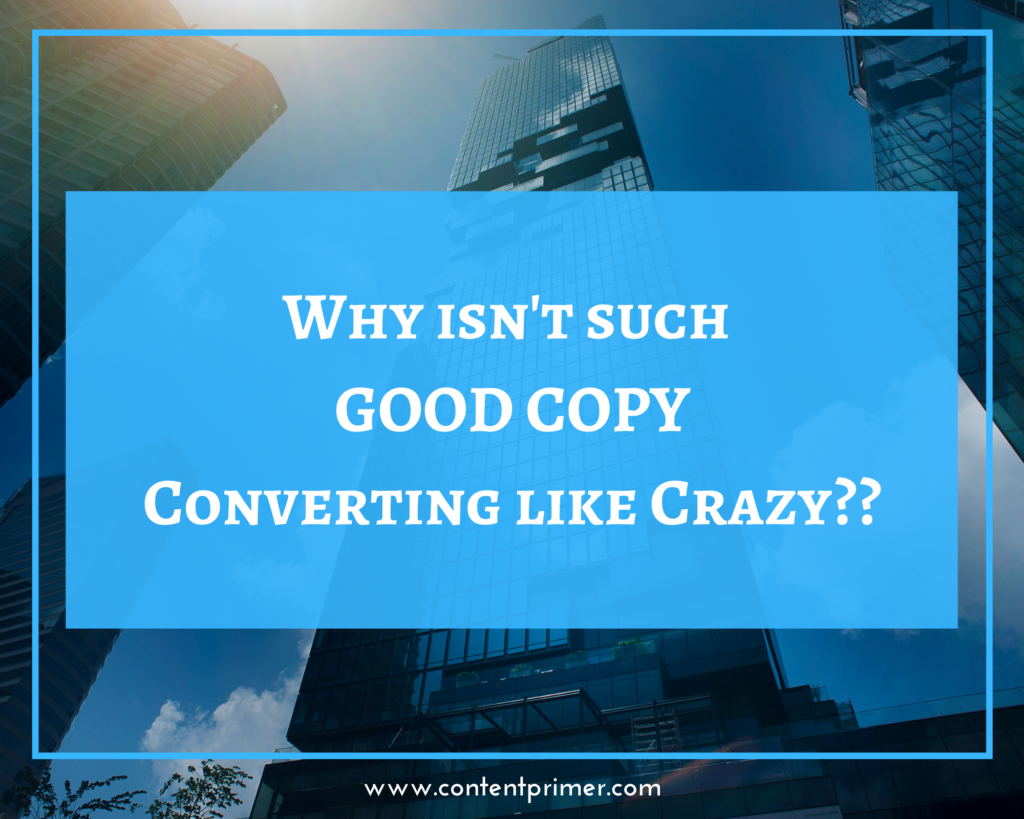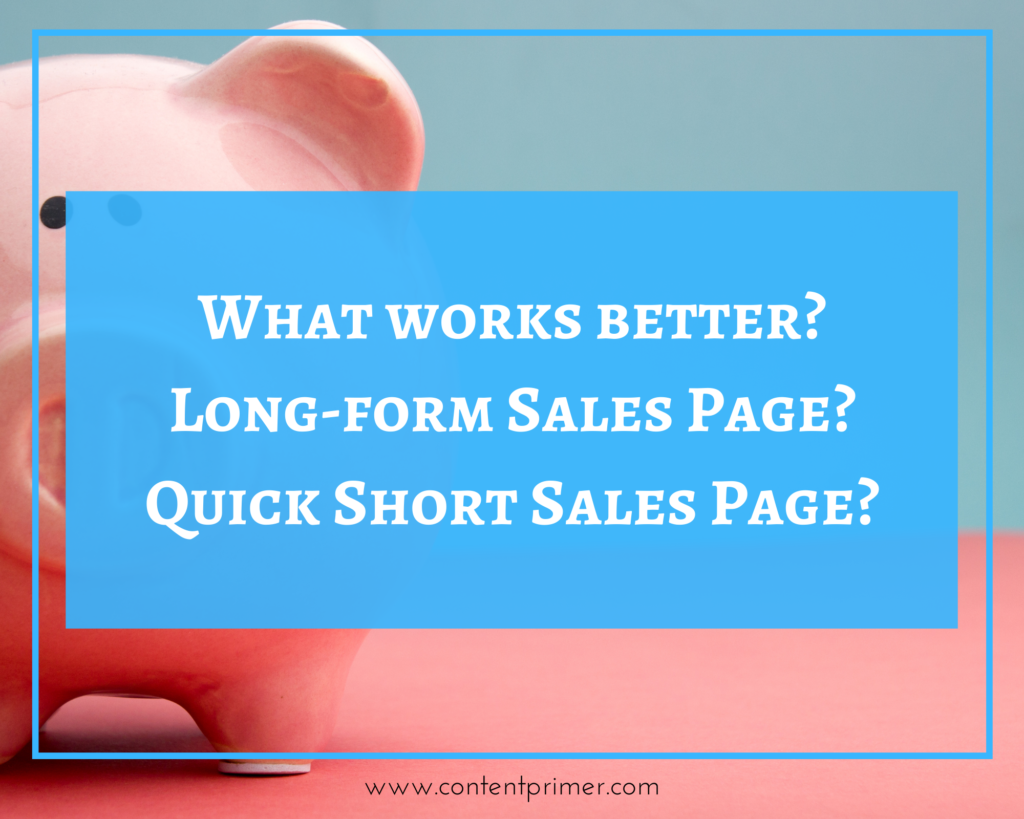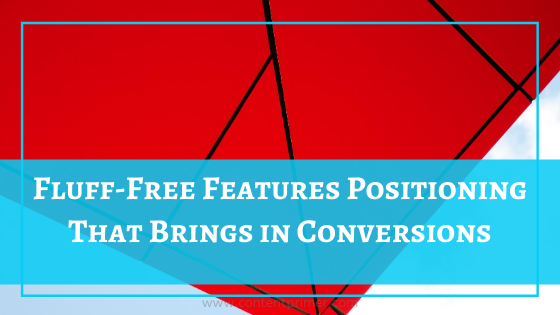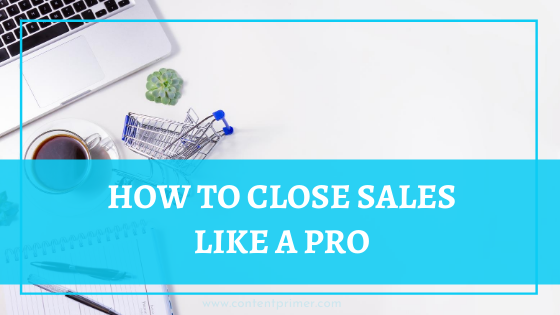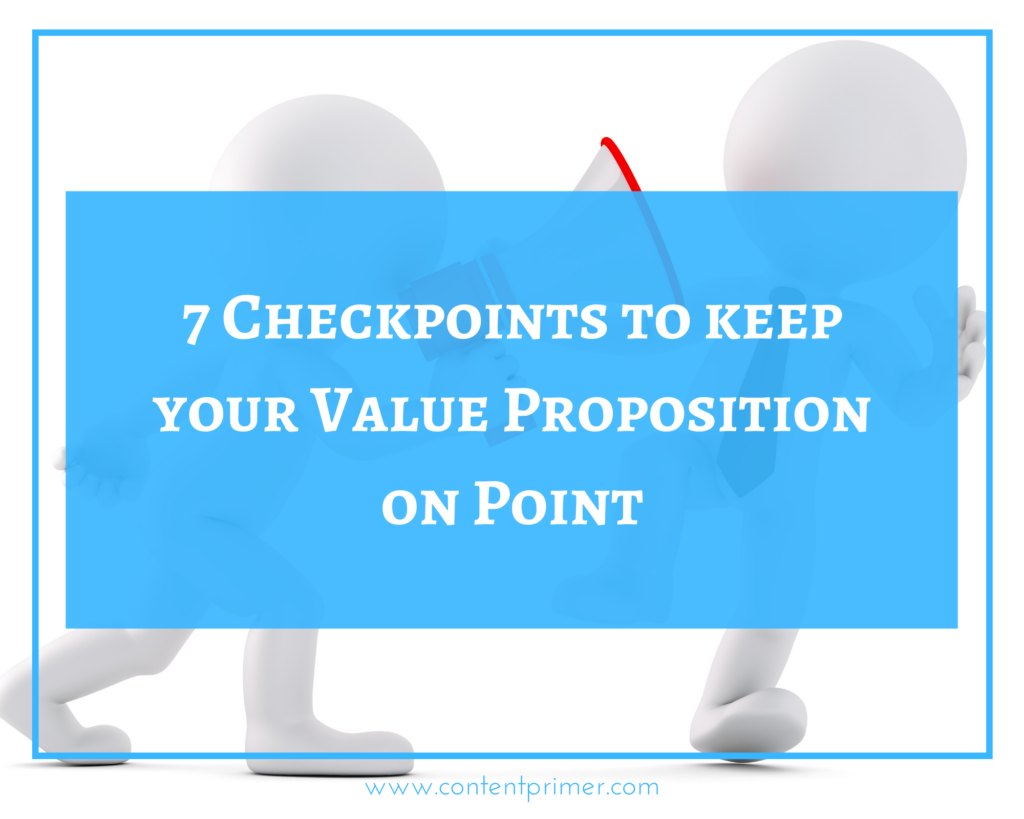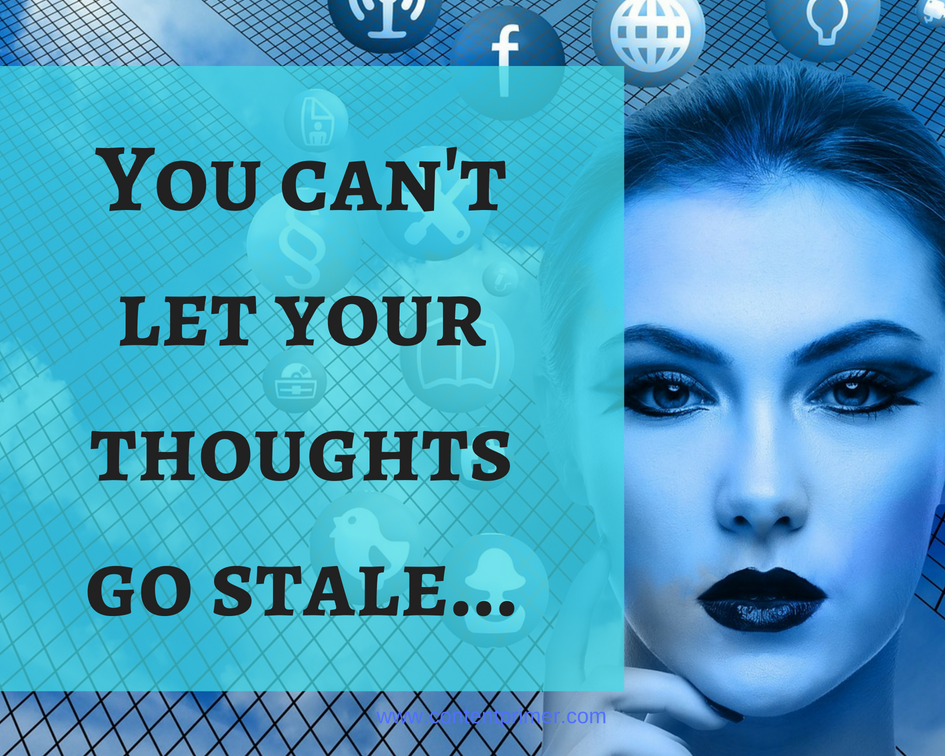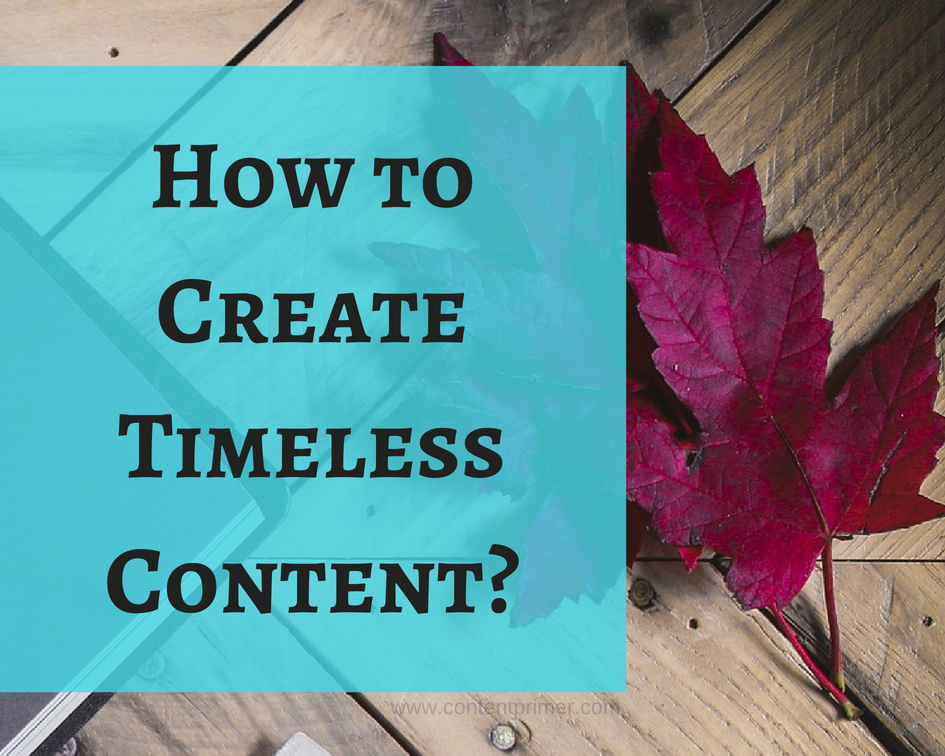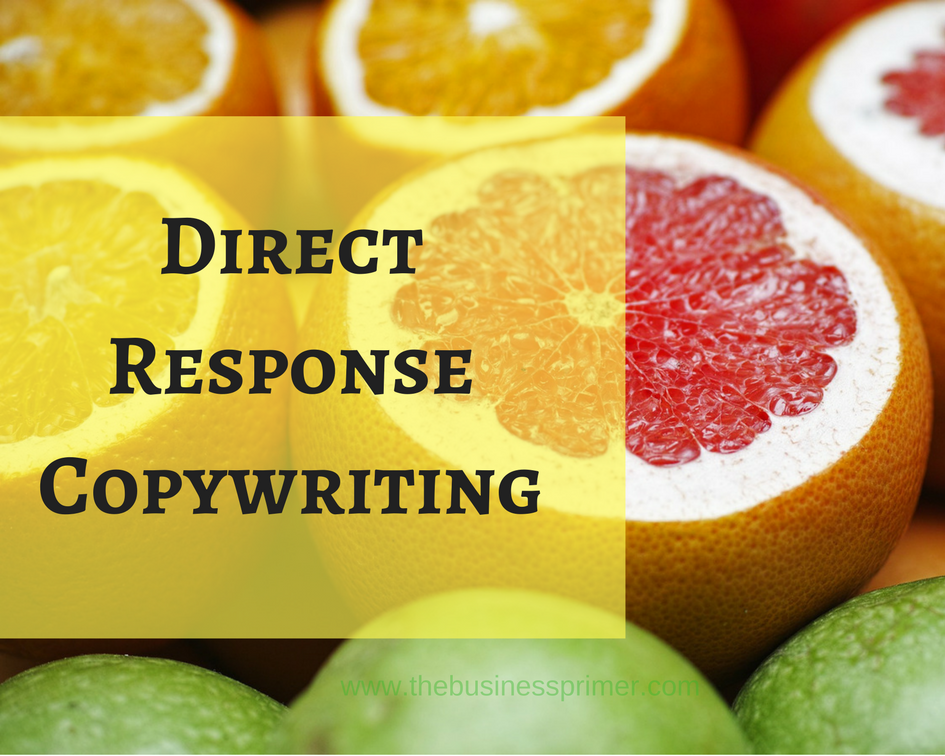Copywriting
Tripwire Sales Page Copy 101: What converts better?
**It** doesn’t really matter to the buyer.
Because..
1. The buyer is not here to measure the length of the sales page
2. The buyer is not here to count the number of words
3. The buyer is not here to admire the beauty of your design. If the design is fab, they’ll definitely admire it. But the sole purpose on the page is to **know** the product.
Your potential buyers are here to see if they’re:
2. Is it worth the money – even if it’s a tripwire product
3. Who’s the creator? Is the creator credible?
4. What kind of results have past buyers seen?
5. What am I really getting if I buy this product today?
6. What will I lose if I don’t buy this product today?
7. What can I do with this product? The ROI?
8. What big worry can this product get rid of for me?
9. How much time can I save per week if I use this product?
What should you keep in mind before writing a Sales Page
2. What’s their biggest worry right now? What are their current roadblocks?
3. How are they looking at solving this?
4. List of product features + benefits
5. Prove your authority and credibility as the product creator
6. List of Frequently Asked Questions so that you don’t leave them frazzled at any point
7. Ample social proof to back up your claims and offer
8. What’s the purpose behind the purchase of a product like this?
9. Address the possible objections to buying this product
10. How can I speed up conversions and maximize sales?
Elementor Product Page Copy Teardown: How to write a Fluff-Free Features List
#Elementor decided to inject my feed with their ads.
So I decided to tear down their sales page into Conversion Copy.
The biggest dilemma before writing a sales page is:
Should you start your sales page with benefits over features?
Not necessary.
You don’t have to force benefits out of the page when the benefits don’t want to come.
What does that mean?
Look at the Elementor sales page screenshot below.
It looks like they were hell-bent on leading with benefits and in the process, the message sounds blah..
Alternatively, fluff-free positioning and features list looks like this, in that order:
- Build the page of your choice with the form builder
- Choose from a variety of well-designed, visually appealing testimonial carousels instead of the same old monotonous templates.
- Built-in pop-up forms so that you have everything hosted on one integrated platform instead of scattered forms and pages.
- Countdown timer to catalyze conversions.
- Capture real social proof to boost your credibility with the Star Rating Widget.
Go over these options and compare it to the copy in the screenshot.
What’s the difference?
- Copy Positioning in the screenshot is so weak and bleak that you CAN fall asleep reading it
- The tone and voice in the screenshot is plain blah. There’s ZERO personality. It doesn’t even sound like everyone else. It sounds unsure and shallow which is worse than sounding like everyone else.
- The copy sounds desperate. It’s trying so hard to be clever by using phrases like “Make it count” — what does that even mean?
The point is — to state the facts and speak the truth straight instead of mincing your words.
So every time you sit down to write sales page copy, do this one thing:
- Try and make sense out of it
Go apply the above DON’Ts to make your copy pop out and shine.
And if you need help with copy audits, reach out to me at roshni@contentprimer.com
– Roshni
You know why it’s hard to sell your services?
Because you’re undecided in your head.
You don’t know how to value your services.
You don’t know how to evaluate the value of what you do.
You don’t know the impact you’re creating with your work.
If you can articulate the impact, they’ll never question your price.
But..
If a price objection comes up and you dilly your way by matching up the price to the time you’re spending, the creativity you’re using or years of experience you’re carrying — it doesn’t cut it!
Because what’s your client gonna do with your experience? Creativity? Time spend?
How’s it beneficial for them?
Noo – it isn’t!
Show them what’s of value.
Show them WHY they should hire you instead of your competitor sitting in the adjacent browser tab.
Because your creativity, experience, and time is NOT a measure of the outcomes they’re expecting.
The same shit applies to online sales as well.
Your copy should just CONVERT – by stating the VALUE your work brings to the table.
Not the hours you’re pouring into the project.
And if you’re finding it hard to articulate the value of the work you do, I help you do just that.
Love,
Roshni
How To Write Value Propositions That Make Your Prospects Say Yes To You
Premature positioning without translatable proof crashes your credibility.
The job of a value proposition is to gravitate your prospects toward saying yes to you.
Humans are constantly looking to benefit. Use this behavior to your advantage.
Let’s look at the value propositions of various websites and audit the copy for conversions.
Example 1:
Stop defining your company with a weak adjective

The above value prop is – braggy.
Also, I had never heard of Cypher learning until now. Adjectives like best, world-class, and high-quality mean nothing. They’re just filler copy.
“Spotting a pretty adjective is the first sign of a fluffy value propositions statement.”
– Roshni Shaikh
“High-quality” just means “high quality”.
There’s no other way to measure it. Because it’s subjective.
Therefore, your value propositions should never depend on adjectives to define them.
Adjectives can never communicate the real value of your business offers. Behead the adjectives out of your value prop and focus on bringing the outcomes to the forefront.
Why your value prop is not your USP
A few days back, Peep Laja, the founder of ConversionXL tweeted about why the concept of USP is obsolete.
And I agree with him.
Because in 2023, it’s impossible to be running an extremely unique business.
Especially, if you’re in the SaaS market – you know how crowded this industry is. So describing your brand as unique is not a good idea at all.

What does the absence of a value proposition do?

My first thought goes – how do you make your results colorful? Colorful pie chart? Colored graphs? Rainbow data?
I feel confused and I start wondering what the product actually is.
Unfortunately, it’s a web development company.
Solution: They could have spoken about the approach they mention in the CTA and position their brand with a clarified message.
Why it’s important to state the biggest benefit – FIRST

Nobody actually needs more data in this data-saturated world. But everyone wants to be able to manage data well.
So saying “Need more data” is not only useless but also intimidating.
And having data is not a benefit. It’s actually a liability to deal with if you don’t know how to tackle the data overflow problem every company faces today.
So if you’re a company offering a solution to analyze, organize, optimize and monetize your data, you should as well state this fact in your value prop and lead with it to bring in conversions.
Otherwise, you confuse your readers. And confused readers get off the wagon ASAP.
Lesson: Lead your value prop with your biggest benefit
Keep your first screen clean
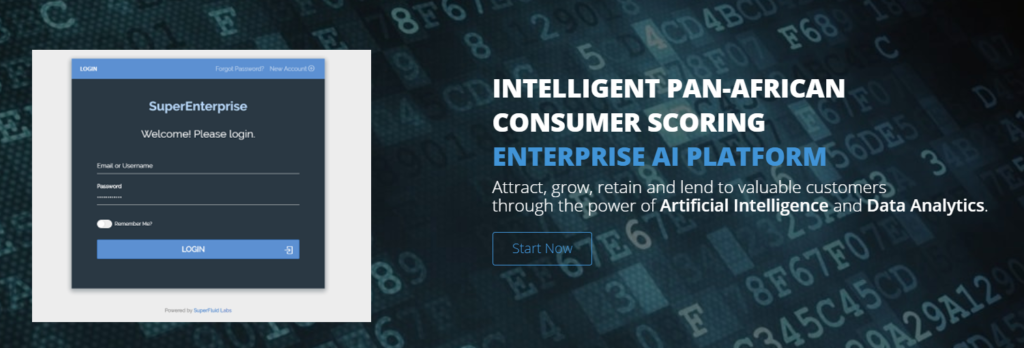
Again, here’s another value prop starting with an adjective. We know what the problem is. So let’s talk about the UX here.
The goal of a business website is to make your reader’s job easy.
You start with clean websites. The screenshot of a login portal to the left is confusing and meaningless. It doesn’t add any value to the message.
The objective of your message is to take your reader from one awareness stage to a deeper, better understanding of your brand.
When you add screenshots like the one shown above, it makes the reader think hard, they panic and quit the page.
Conclusion: The reader cannot grasp what this company is about until they read the tiny text that uses two keywords (AI and data analytics) in an unnatural sentence.
Solution: A hero section with no image is better than having a confusing, deviating image with an unclear value proposition.
Avoid writing unprofitable value propositions

Stating your own name in the value prop has zero benefits.
This isn’t telling me what kind of digital work you do.
The words “more and beyond” denote uncertainty. If the reader senses uncertainty, they’ll have a hard time trusting your brand.
So, use your online real estate wisely. Own your message, connect with your audience and bring them closer to your brand.
But how?
3 simple ways to make your brand more approachable
- Write a benefit-packed value prop with a meaningful call to action
Look at the example below. Appsumo doesn’t waste a second in addressing its readers. They identify the software buyers immediately. They know exactly what the software buyers come to them for. They make them feel exclusive instantly. This is a 10/10.

- Connect with a belief your audience stands for
Meetup does this really well.
Their value prop says – “The real world is calling”, which connects with most of us on so many levels because we’re all fighting digital screen toxicity.
We’re all striving to make our lives a little bit more outdoor-ish. The gist is – to find out how you can match your audience’s mindset and convey that.
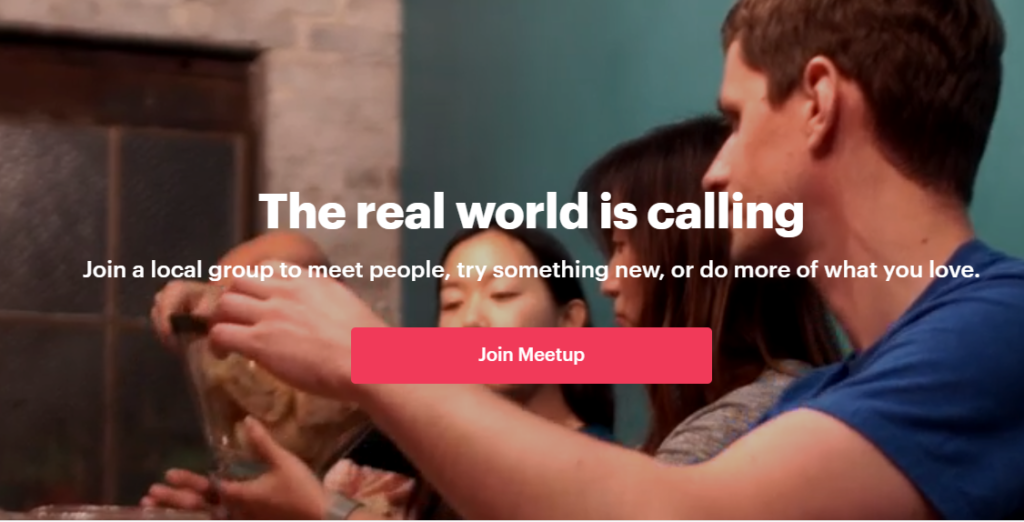
- State your why loud and clear just like 450GSM
They’re not afraid to break the rules. The moment you land on their homepage, it’s clear.
There are no clever tactics, no desperate messaging to sound badass – only clear messaging that gets the job done.
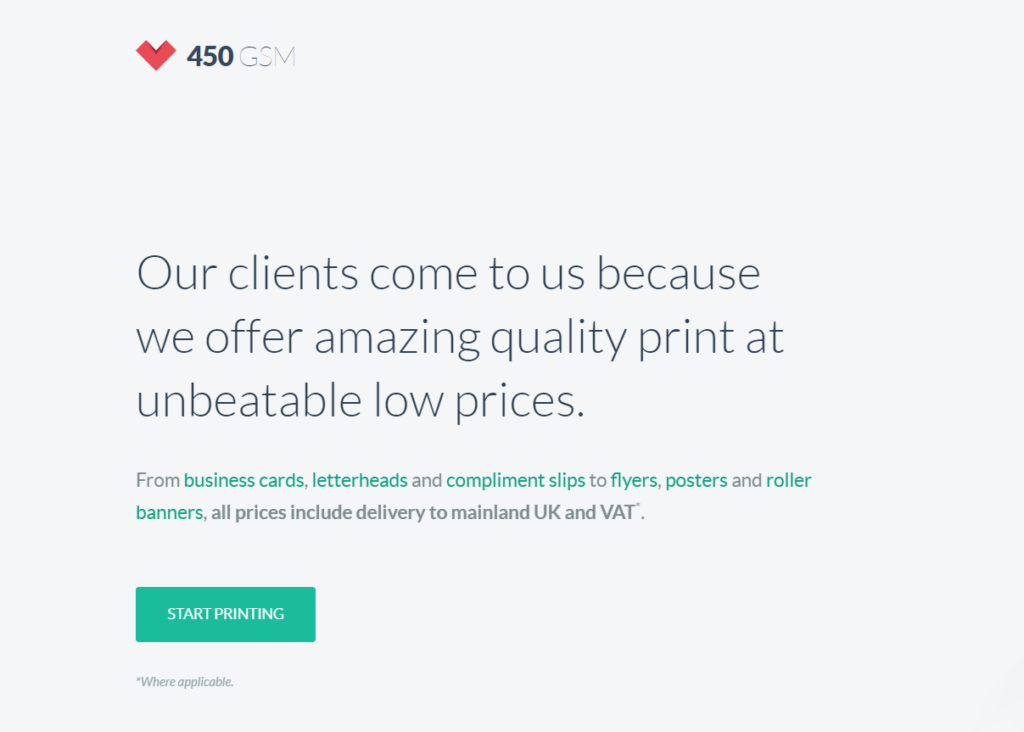
Action steps to writing a clear value proposition
- Avoid adjectives – because adjectives repel clarity and are subjective
- Highlight the biggest benefit
- Use social proof to write your value proposition if you can
- Connect with the values and beliefs of your audience
- Connect with your reader’s mindset and intent
- Clean UX around your value prop means higher conversions
- Stop trying to be unique and focus on being useful to your readers
Questions? Ask me in the comments.
How to upgrade how your audience perceives your content
Content is the endocrine system that creates the image of your company. Content is what makes your company a brand.
Pick any big name and you know about it because of the reach the company has had. This kind of outreach is a product of consistent content marketing efforts the brand has invested in to reap the benfits of consistent lead flow in the long term.
But creating on-brand, value-based, educative content is not an easy affair. It takes months of planning and consistent creative efforts to come up with content your audience revere.
Employ these 5 essential strategies to create timeless content that attracts your best seeker.
| 5 Essential Strategies to create timeless content |
|
Create content that is hard to copy
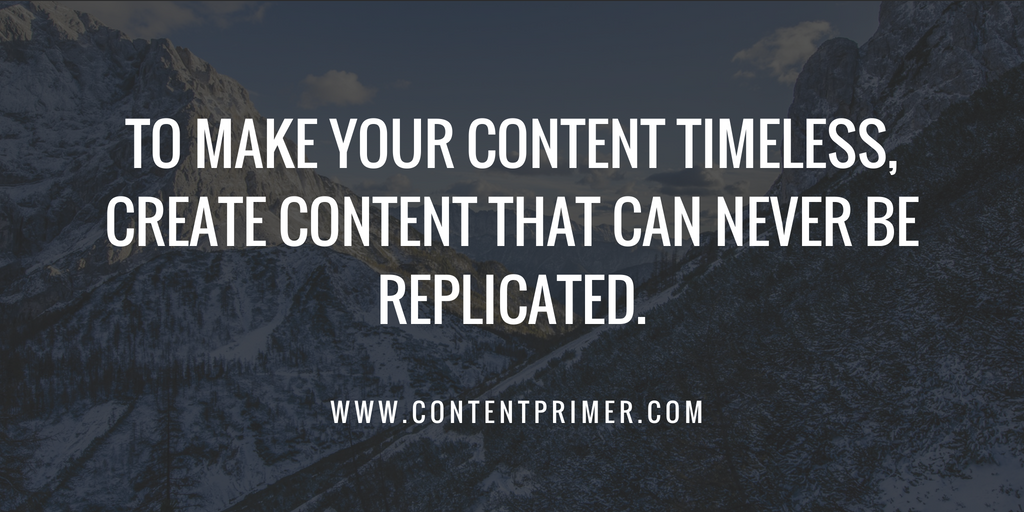
If you want to make your content an experience, it has to be unique and individualized.
To make it unique, use excerpts from your own business interactions. Talk about events that occurred between you and your clients. Narrate de facto episodes and instances in your content.
The one thing people can’t steal from you is your experience. It’s exclusive to you. Now, how do you apply this idea and use it to your advantage to create content?
Talk about your work process that highlights the direction your prospect is hungry for. When you highlight your work process in a blog or case study or any of your company marketing material, you’re instantly checking off objections in your audience’s minds by:
- Feeding their curiosity – by giving the exact steps they’ll be walked through during your work process
- Eliminating anxiety – by mapping out clear directions
- Establishing authority – clear processes are a result of the experience that comes from the learning you’ve applied from your failures
Content that connects relieves your audience and builds their confidence because they now believe they’ve found the solution they’ve always wanted. It’s like going to meet your audience at a point where they are, instead of asking them for directions.
Banking on the not-so good-things
You can bring your negative experiences and present them as valuable lessons. To show you how – nobody knows about the challenges you have faced in coming up with the robust system you have now. I am sure you have learned your lessons from this. Turn this experience into a shareable excerpt that instills trust and confidence in your readers.
By talking about these learnings, you demonstrate your openness. Plus, you are bringing a real story that has lived with you. Real stories are charming because everybody wants to know what happened to your product/event/client meeting at the end. That’s what it means to show and not just tell.
Help your content with the what happened angle and you will be, remembered.
Create content that is easy to use
The web is filled with beaten content. It’s either overused or still greasy.
Starting your headlines with facts and figures used to be a thing where an average writer would stick an unimportant stat in the headline just to make it more believable even though the headline never explained how it was beneficial. And when you do that, you almost never convince your reader to actually click on the headline. All your effort goes in vain.
Easily consumable content is:
- Clear and concise
- Beneficial
- Visually appealing
- Actionable (not just inspirational)
The great content overwhelm
Let’s talk about the other face of marketing – Content Fatigue
Do your readers a favor, save them that unwanted stress! If the gurus tell you to write a minimum of 2000 words and the content you are creating doesn’t stretch that far, then do not write 2000 words just to keep up with a random rule.
Write for your readers, not for rules.
Creating flubby-dubby conundrums or writing lengthy unwanted stories, stuffing images unnecessarily, throwing in stats at the drop of a hat makes your content forced and coerced. Avoid. All of this.
Is grammar and spellings everything?
Although the internet may forgive you for typos, sometimes, bumbling with grammar and syntax can get annoying.
You instantly look down upon a piece of writing that that calls more than one mouse mouses instead of mice. Agree?
Sometimes, typos can get annoying as silly errors tend to change the meaning of a sentence completely leaving the reader baffled and thwarted.
For example:
“Their wasn’t a way out” – sounds awfully misleading and confusing. Yes?
But, in a quest to obsess over grammar, syntax, and spellings, don’t ignore the big work.
Typos can be forgiven if the content is exceptional. – Adam Connell
Adam Connell, the chief wizard behind Blogging Wizard goes on to say – “We’re only human, so mistakes happen. That said, when people find typos, it can cause them to question the credibility of a website – particularly in sales copy or any page that someone would use to evaluate a buying decision.
Ultimately, how significantly typos impact your results can largely depend on the type of content and exactly who your audience is.”
So, if you do not want to risk your position, it is best to avoid typos and severe grammar errors that question your credibility.
Create content to connect with your readers
We write and create content to communicate what we know and express what we think. This is just one side of the story.
Your readers read your content because they want to learn, know, make aware, be informed and ultimately feel how they want to feel. That is why, it is important to write content that influences, and not just informs.
Sharp writers choose each word with piercing precision. – Henneke Duistermaat
No doubt Henneke is the best of writers. She knows how to evoke your senses. Look at the choice of her words – piercing precision! Isn’t that incredible? Your word selection makes or breaks your content. Because there’s no choice – you have to be empathetic when you’re writing. You have to give your audience what they’re searching for. If you promised a solution in your headline, deliver it. If you promised a result in your headline deliver it. That’s how you connect and keep your readers.
Do not deviate from purpose and context
Are stories overdone? We all know that marketing pushes stories like it’s the bloodline of the marketing system. Stories are being pumped into content like never before.
But, what we see today, especially in email newsletters is a bunch of irrelevant, irreverent stories with a connection so weak that you begin to hate business emails.
What should you do?
Cut the crap and deliver what is needed. Even if you have to break rules.
When the whole world is drumming about using stories in your content, it is alright to go without it if you do not have a worthy story that connects.
I have seen emails with subject lines like “My mother’s death anniversary + Fast action bonuses“. I find this kind of subject lines obnoxiously careless and insensitive. You too, right?
Capitalizing on your mother’s death and mixing business by writing a story in the email about how loving your mommy was – an absolute NO!
It is a huge turn-off and people unsubscribe. You don’t have to bring your mother’s death anniversary to build context. It is off-putting.
So please, avoid using such click-bait headlines and cheesy marketing tactics. It is 2020! If you promise something in your headline, make sure you keep your promise by delivering what you are supposed to.
Tip: Check how to write promising headlines and also keep the promise.
Conclusion
Evergreen content is continuously improvised and nurtured. It is not a one-time task, it is a process. So, to summarize:
Timeless content is – exclusive, consumable, grammatically correct, evoking and in context.
What do you do to make your content evergreen? Do you have anything else to add to this list? Tell me in the comments below.
What is copywriting and why every business needs it?
Copywriting. This term can be condescending, I know.
The word “copywriting” can evoke baffling questions like these:
Is copywriting about copying? Is it copy-pasting?
No kidding, such questions are asked for real.
So, what is copywriting?
Copywriting is the art and science of putting words that absolve the reader’s objections and persuade the reader to take a pre-defined action.
Good copywriting is backed by a thorough study of the psychological behavior of the business’ audience. It involves a step by step procedure that gathers detailed information about the target visitor.
In the digital age, copywriting is synonymous with web copywriting or direct response copywriting. Web copy is written to lead the target prospect to act on a CTA.
Copywriting is an intense process. As a copywriter, it is your responsibility to know your customer’s business in and out. The business functions, benefits, features, USP, value proposition, objections, problems, FAQs, mission, vision, audience and so much more.
What does a typical copywriting process look like?
- Ideally, a copywriter gets business information from the client in the form of a questionnaire with specific answers. Specificity is the key. It is up to the copywriter to ask questions that fetch unambiguous information avoiding back and forth communication.
- Based on the information in the questionnaire, the copywriter studies the customer info and derives a customer profile.
- The copywriter designs a wireframe sketch to make the copy come with a flow. The wireframe sketch decides the fluidity of the copy.
- The positives and features of the product or service are aggregated and converted into benefits.
- The copywriter comes up with a clear value proposition that tells the purpose of the business website. No beating around the bush here. It has to be clear and concise.
- This is followed by rounds of editing, search engine optimization and testing the copy.
Note: A prospect is determined by the business whose products are designed for a certain demographic.
Why should a copywriter know everything about the company?
To define the value proposition
You are writing copy for the company’s customer. You are writing copy to convince the prospect. The prospective visitor comes with many questions. Answering all their in-mind questions on-page is the goal of web copy.
In order to answer their questions, you should know the business inside out. If you do not know about the company functions and operations unique to that company, your value proposition fails. If you do not know why the company does what it does, you fail to get the purpose in words.
The value proposition is the most distilled version of the company’s prime purpose.
To understand and reproduce the purpose
When the “why” is not projected strongly, there is nothing that moves the prospect to establish an emotional connect. The emotional connect is not about instantly liking your brand. It is about a feeling your words can evoke
Let’s talk about a common activity you and I both do. Do you feel good shopping on a website that sells the products you love at your happy price? Do you see the key-points here? Love..Happy!
Ultimately, you do what you do to make yourself feel the way you want to. Even if it means trading money.
Jim Keenan, the author of Not Taught says you cannot sell to your prospect if the prospect doesn’t perceive value in your product or service. The “value” here can take any form. But it eventually boils down to a feeling. An emotional state of content that happens after an action.
Great copywriting is about salvation, not sales. – Aaron Orendorff
When you invest your money in a worthy product, you willingly trade your hard earned money because you have assigned a value to the product. That is all a customer pays for – Salvation. And, copywriting is the art and science that brings out the value out of a product and projects it in the form of words.
If you succeed to provide that reason of fulfillment your prospect is looking for, you have written good copy. That is when your copy becomes convincing. You don’t need to put any more effort, even in terms of fancy-glittery graphics. They do not matter. All you have to do now is drive your prospect to take an action. The sale is just a resultant action. And, congratulations! You just sold your product.
How to edit your copy?
To get the most pristine version of your copy, try removing one random word from one random sentence of your final copy. If you see a discrepancy, in any form, you put back the word and publish it. If not, repeat the distillation process.
Good copy is achieved when if you remove a word from the line, it obstructs the meaning of the sentence terribly.
Why is copywriting called copywriting?

The above definition implies that anything worthy of being reproduced to preserve its existential value is copy. This highlights the monumental importance copywriting holds in the business world.
Why every business needs copywriting?
When I began my career as a copywriter, I wondered what copyblogger meant. It sounded weird. I get it, the word is formed by the amalgamation of two words copywriter and blogger. But why? Why would anybody do that?
Now, when I know why every business needs copy, I fully understand the profound reasoning behind naming the legendary website CopyBlogger. In simple terms, CopyBlogger is a resource that teaches you conversion blogging or business blogging but not limited to blogging.
It is all about conversions. You cannot grow your business without conversions. Can you?
You need copy to convert.
Copy that converts + A well positioned product = Sales that spike your revenue
And after all, sales is the ultimate goal of any ethical business. Now that you know why every business needs copywriting, what are the steps you are going to take to write copy?
